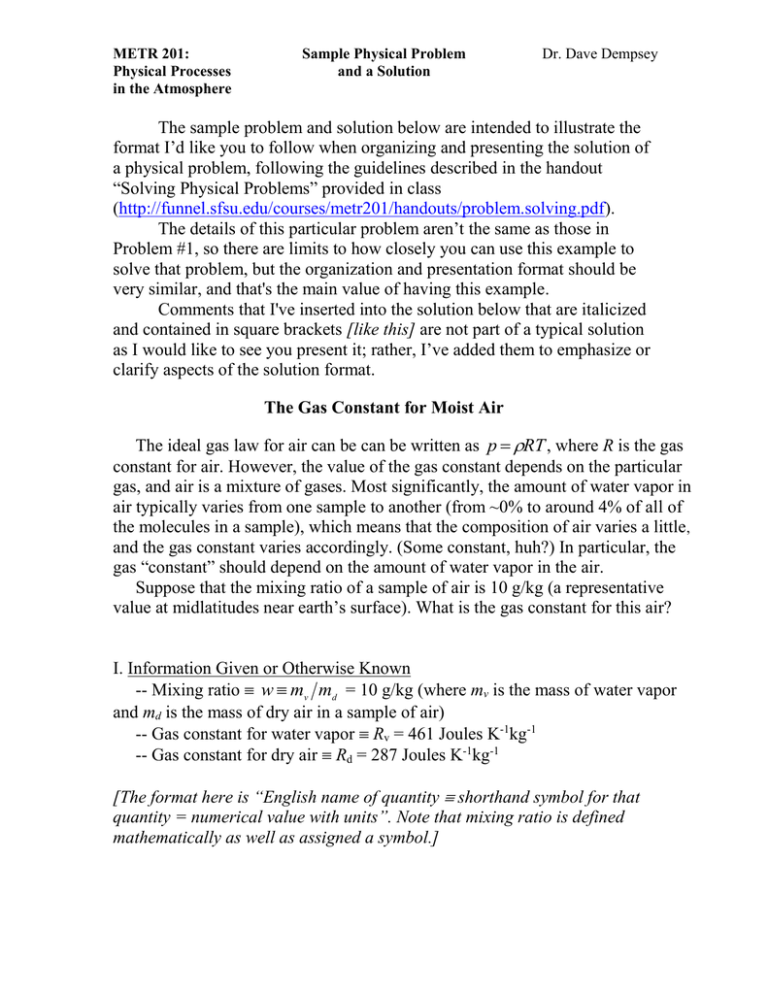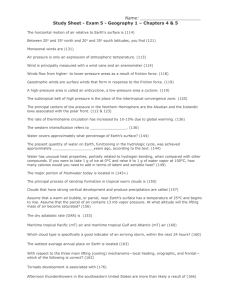METR 201: Sample Physical Problem Dr. Dave Dempsey
advertisement

METR 201: Physical Processes in the Atmosphere Sample Physical Problem and a Solution Dr. Dave Dempsey The sample problem and solution below are intended to illustrate the format I’d like you to follow when organizing and presenting the solution of a physical problem, following the guidelines described in the handout “Solving Physical Problems” provided in class (http://funnel.sfsu.edu/courses/metr201/handouts/problem.solving.pdf). The details of this particular problem aren’t the same as those in Problem #1, so there are limits to how closely you can use this example to solve that problem, but the organization and presentation format should be very similar, and that's the main value of having this example. Comments that I've inserted into the solution below that are italicized and contained in square brackets [like this] are not part of a typical solution as I would like to see you present it; rather, I’ve added them to emphasize or clarify aspects of the solution format. The Gas Constant for Moist Air The ideal gas law for air can be can be written as p RT , where R is the gas constant for air. However, the value of the gas constant depends on the particular gas, and air is a mixture of gases. Most significantly, the amount of water vapor in air typically varies from one sample to another (from ~0% to around 4% of all of the composition of air varies a little , the molecules in a sample), which means that and the gas constant varies accordingly. (Some constant, huh?) In particular, the gas “constant” should depend on the amount of water vapor in the air. Suppose that the mixing ratio of a sample of air is 10 g/kg (a representative value at midlatitudes near earth’s surface). What is the gas constant for this air? I. Information Given or Otherwise Known -- Mixing ratio w mv md = 10 g/kg (where mv is the mass of water vapor and md is the mass of dry air in a sample of air) -- Gas constant for water vapor Rv = 461 Joules K-1kg-1 -- Gas constant for dry air Rd = 287 Joules K-1kg-1 [The format here is “English name of quantity shorthand symbol for that quantity = numerical value with units”. Note that mixing ratio is defined mathematically as well as assigned a symbol.] II. Information Desired Gas constant for moist air R III. Relations Needed m (1) p RT (ideal gas law for air) V (where p is the pressure, m is the mass of air in a parcel, V is the volume of the parcel, and T is the absolute temperature of the parcel) m (2) pd d Rd T (ideal gas law for dry air) V (where pd is the partial pressure of dry air in a parcel and md is the mass of dry air in the parcel) m (3) e v RvT (ideal gas law for water vapor) V (where e is the vapor pressure, which is the partial pressure of water vapor in a parcel; and m v is the mass of water vapor in the parcel) (4) m mv md (5) p e pd (mass of a parcel is the sum of the masses of the parcel’s constituents) (total pressure is the sum of the partial pressures) [Note that each relation is numbered for easy reference later and is named or, if it doesn’t have a name, is described in some way. Any new symbols appearing in a relation that were not defined earlier are defined in English. Note also that physical relations use the “=” sign while definitions use the “” symbol. To solve any physical problem like this, you generally need to have as many independent equations as you have unknown quantities appearing in them. In this case, there are nine quantities that we don’t know—the three pressures, the three masses, the volume, the temperature, and the gas constant for moist air—but only five independent equations plus the value of the mixing ratio. This doesn’t look promising at all! Fortunately, as you’ll see below, in this case it turns out that we don’t actually need three more equations. Whew!] 2 IV. Solution (A) Substitute (4) and (5) into (1): m m d (6) e pd v R T V [Each step in the solution is labeled, in this case by a capital letter, which can’t be confused with the numbers assigned to relations. Each relation is referred to using the number assigned to it earlier. A statement such as “substitute (4) into (1)” is unambiguous; the left-hand side of relation (4) is a single quantity, which is replaced in relation (1) by the right-hand side of relation (4). The relation that results from the substitution(s) is given its own number.] (B) Substitute (2) and (3) into (6): (7) m m d mv m RvT d Rd T v RT V V V (C) Solve (4) for m v , substitute into (7), and factor out like terms: wm m d wmd m RvT d Rd T d R T V V V so (8) wRv Rd md m T w 1 d RT V V (D) Divide (8) by (9) md T and solve for R: V wRv Rd w 1 R md T cancels all three quantities from both sides of the V equation, which is why we didn’t need three more equations to solve the problem! A box around the final symbolic solution highlights the solution.] [Note that dividing by 3 (E) Substitute values and units into (9) and compute the numerical solution: 10g/kg 461 JK R 1 kg 1 287 JK 1 kg 1 10g/kg 1 10 kg/g 10g/kg 461 JK 1kg 1 287 JK 1kg 1 (convert grams to kilograms) 3 10 kg/g 10g/kg 1 3 10 10 461 kg/g g/kg JK 1 kg 1 287 JK 1 kg 1 10 3 10 kg/g g/kg 1 3 [This last step grouped units, powers of ten, and numbers separately.] 10 3 10 461 JK 1 kg 1 287 JK 1 kg 1 = 10 3 10 +1 [This last step simplifies the units: in particular, the units in kg/g x g/kg cancel out.] 10 2 461 JK 1 kg 1 287 JK 1 kg 1 [In this step, powers of ten are consolidated.] 10 2 +1 4.61 JK 1 kg 1 287 JK 1 kg 1 0.01 +1 [In these steps, arithmetic calculations are done.] 291.61 JK 1 kg 1 1.01 R 289 JK 1kg1 [The numerical solution gets its own highlighted box. Only three significant digits are shown because that’s the smallest number of significant digits of any of the quantities used to calculate R. That smallest number limits the precision with which we can compute R.] V. Check Solution We expect a positive number, and we got it. The units are the same as for other gas constants, as they must be. The value is a little higher than the gas constant for dry air. We might expect this because the gas constant for water vapor is greater than the gas constant for dry air, so the gas constant for a mixture of dry air and water vapor (that is, moist air) should be higher than the gas constant for dry air alone. The amount of water vapor present is small (around 1% by mass, corresponding to the given mixing ratio of 10 g/kg) so the gas constant for moist air shouldn’t be dramatically greater than it is for dry air alone. 4







